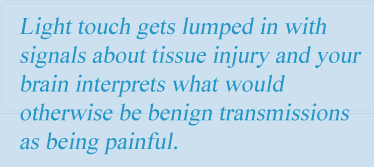Possible Causes
Neurons Switch Function
Your nervous system is more than a network of wires that mindlessly transmit signals. Neurons have a mind of their own (i.e., a nucleus with genetic programming) and can alter the way they function. This moldable nature is how your CNS jumps into action to contain infections, resolve injuries, or other threats to your body. It also helps your brain learn new information. It is constantly changing … but not always for the best.

In the case of fibromyalgia, there is no obvious destruction of tissues, but your peripheral systems may still be signaling that something is wrong. The exact nature of these peripheral signals is unknown, but it appears as though the neurons in the cord are operating off script as though they are under siege. And multiple malfunctions in the CNS may compound your diverse array of symptoms.
The number of transmissions arriving at the spinal cord is mind-boggling, so the cord has a system to prioritize which signals reach the brain. Neurons dedicated to carrying noxious sensory information must meet a higher threshold for entrance of their signal into the cord than those conveying essential yet benign info. Examples of the latter include signals about muscle movement and light touch.
How do you conceptualize what is going on? Signals from the noxious sensory neurons must climb over a tall gate to gain entrance to the cord. But in the case of fibromyalgia, the cord’s entry neurons have switched to a lower threshold. It’s as though the gate is left wide open for everything to stroll on in.
The genetic change in the cord’s sensory neurons is the reason for your reduced pain threshold. Now, light touch gets lumped in with signals about tissue injury and your brain interprets what would otherwise be benign transmissions as being painful.
With the dramatic increase in the number of signals entering the cord, the spinal neurons get hammered. This turns on special receptors, called NMDAs, which ordinarily sit quietly on the sidelines. The NMDAs work like a fail-safe mechanism to make sure your brain is aware of the situation, and they do so by amplifying the incoming signals. Once the problem is resolved (i.e., injury or threat to the body is gone), the NMDAs should be benched and gagged … but they remain a rowdy bunch in fibromyalgia.
Research shows that glutamate, the neurotransmitter known to incite the NMDAs into action, is elevated in the spinal fluid of people with fibromyalgia. Even in the absence of any obvious tissue injury, the NMDAs appear to be stuck in a chronically active state.
The CNS changes that occur in fibromyalgia can distort or amplify pain and cause the awful discomfort to spread throughout the body. But why is your CNS operating in such a dysfunctional manner? The modulation of signals involves the integration of thousands of neurons and the process is constantly changing. The puzzle is complicated by the fact that thousands of neurons may be involved in modulating each signal and this process is constantly changing. So, the reason for your low pain threshold is still unknown and remains an important area of research.
In the meantime, two treatments thought to reduce NMDA activation include magnesium (250 mg twice daily) and dextromethorphan (20-30 mg twice daily). Dextromethorphan is an ingredient in over-the-counter cough syrups, but it can also be compounded into capsules with a prescription.
Blocking NMDA receptors can be a challenge because these same receptors are used in the brain to aid cognitive processes. Too much dextromethorphan can leave you with “no pain AND no brain” — so dose escalation needs to be done slowly. Keep in mind that every patient with fibromyalgia is different. You may have a favorable response to these measures or none at all.
